Frank Clegg, Fall River: Factory visit
It’s not hard to spot an old mill town.
Mills were large buildings and needed lots of light. In Britain, this often came in through so-called sawtooth roofs: a zig-zag shape that allowed windows to be placed in the top of the building, bringing in the sun.
This was less common in America. The roofs were usually flat: but there was still the need for light, and the large rectangular buildings had sides filled with long windows.
Driving into Fall River, Massachusetts this past October, the town’s history was immediately apparent.
As soon as you looked beyond the McDonald’s and Dunkin’ Donuts signs, you could see the preponderance of large, long buildings, with hundreds of windows down the sides.
Fall River and New Bedford were at the heart of the industrial revolution in America. At one point New Bedford was the richest city in the country.
Today, sadly, Fall River is more likely to appear in a list of the worst towns to live in in the US. It’s not the poorest, but industry has largely gone.
Some of those old mills have been turned into flats. But just as common is to see all the windows on an old mill boarded up, as it’s too expensive to repair them.
Frank Clegg Leatherworks is in one of the few to still contain manufacturing.
Not that this is a historic works: Frank and his two sons (Ian and Andrew) have only been here two years, and hope one day to move again and find something more permanent.
They’re on the fifth floor of the building, with a boxing gym next door and a variety of retail on the ground floor.
But it’s clean, and it’s warm, and it's well run.
Our visit was peppered with stories of the other mills in the area, and their managed decline. Burst pipes and poor heating seemed to be the chief complaints, often with stand-offs between owners and tenants that led to people working in unheated buildings through the winter.
This all brings into sharp relief the energy, craft and progressive attitude at Clegg.
It’s a big space - more than enough for the 12 people working there. But it doesn’t feel big.
It's warm and noisy. Music pumps out from a sound system in the corner, with Frank’s collection of a few thousand CDs stacked up around it.
There's everything from Leonard Cohen to Pavarotti in there, though it's mostly rock and country.
The back third of the room is storage, for leather and old samples. Plus a booth for product photography that Ian is excited about.
The front is mostly a showroom, with bags displayed on shelves around the walls.
And so most of the work goes on in the middle, with long tables separating out the different tasks, and a huge American flag hanging from the ceiling above.
Apart from the photo booth, there are several new machines Frank, Ian and Andrew have invested in in recent years.
They were one of the first in the US to use a computer-controlled CNC cutter for leather (above, manned by Andrew), rather than doing it by hand.
And a new skiver has just come in, and is being tested.
“Over time, you learn the little idiosyncrasies of these machines, and the mistakes that are easy to make,” says Frank. “That’s when you start to see marks or guidelines drawn on them, or Post-it Note reminders.”
The family has always been quite progressive when it’s come to new technology.
Frank remembers they were the first to get a particular edge-dyer in the US, in the 1980s. It was imported from Italy, and the only reason they knew how to use it was that their mother read Italian, and could translate the manual.
The company has been through lots of ups and downs since Frank (above) started it.
There have been more and less successful tie-ups. There was the steady move of manufacturing to Asia. At one point, when work was slow, Frank started making guitars as well.
But he has always had a talent for design, and a lot of Frank's original models remain among the company’s best sellers.
Pieces like the Lawyer's Briefcase (above top - middle column, on the floor) are a little too traditional for me, but I love the Zip-Top Briefcase (same column, top), which manages to be sleek and modern, yet practical and masculine.
It is also, I just discovered, the bag President Obama chose for an American-made briefcase.
I have a Large Working Tote (chestnut tumbled leather, acquired in 2011 and still regularly admired); and a tall tote bag, a collaboration between Frank and Michael Bastian (bought 2013).
If could add one more, it would be a custom tote in the beautifully soft nubuck that was laid out on the cutting table when I visited (below).
The next stage for the family is women’s bags, and I saw some very elegant designs with custom hardware.
They were slimmer and more refined than the men’s, but I think still recognisably Clegg, partly due to the colours - even if women apparently favour chrome-dyed leathers with their clean, unblemished surfaces.
The factory also continues to do third-party work, at the moment largely belts for a South American brand. “It’s relatively straightforward compared to bags, but it is a good training ground for new workers,” says Frank.
By the time we’ve finished the tour, had some doughnuts, and talked about the early days in the showroom, the light has changed.
When we drove in this morning from Boston, it was slanting low through those windows, casting long shadows.
Now the sun is high and the space is filled with light. Before everyone heads off for their lunch break, Ian gathers everyone for some group photographs. It’s not often they get a photographer up here.
Then Ian, Frank, Andrew and I head down to the waterfront from some local seafood.
Clegg doesn’t have its own physical retail, but there are 30+ retailers around the world. I’d particularly recommend the selection at The Armoury, and in London there is a small selection at Richard Gelding and Fenwick’s. Full list here.
If you’d like to read more factory visits on Permanent Style, you can find them collected here.
Several of those, including the sawtooth-roofed John Smedley, were also collected in the book Best of British, which I wrote with photographer Horst Friedrichs. That is available here.
Thanks to all at Frank Clegg for your hospitality, and in particular Ian for helping organise the trip.
Photography by M.Studios.


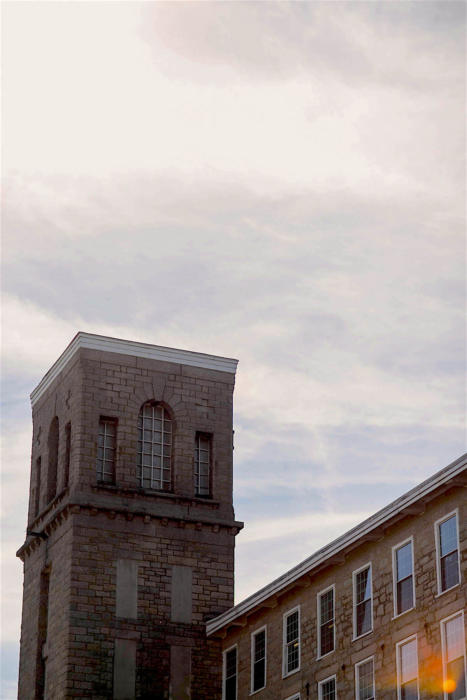
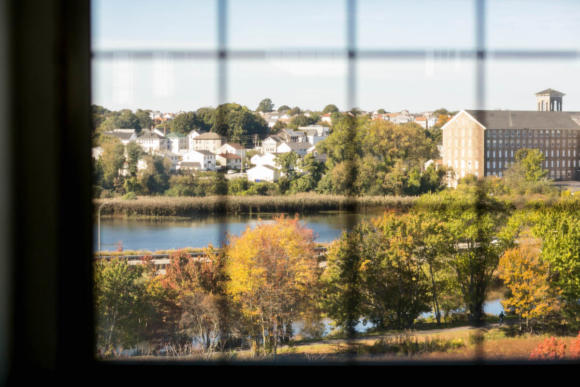
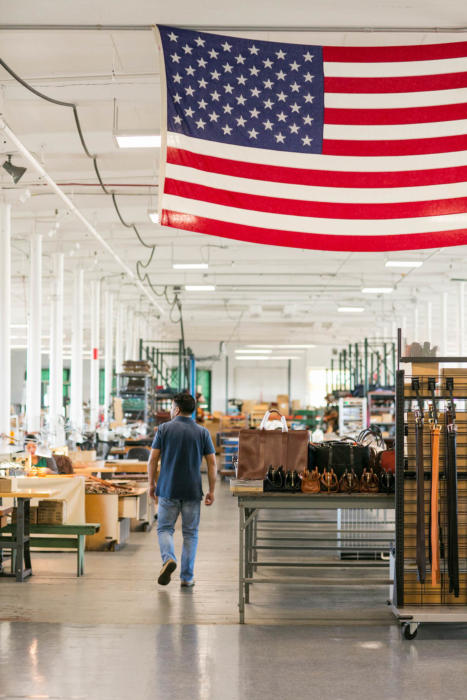
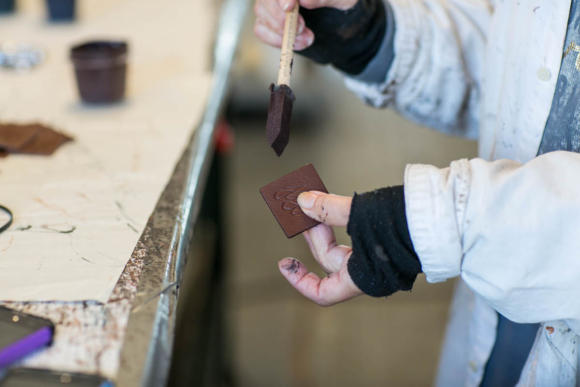
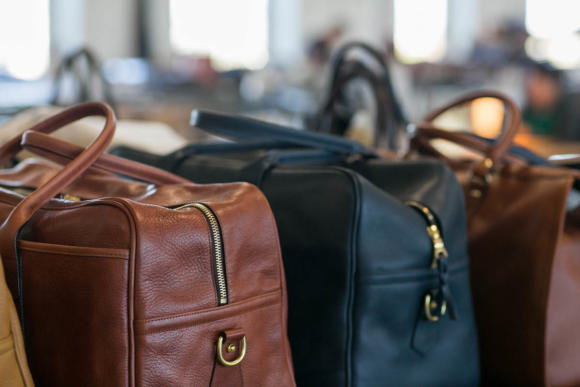

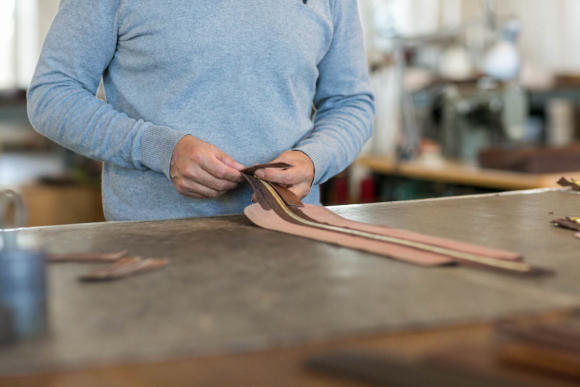
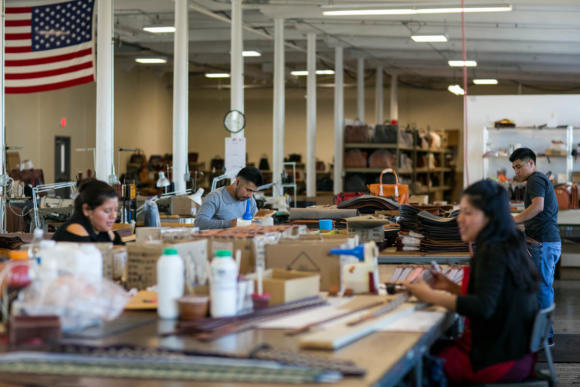
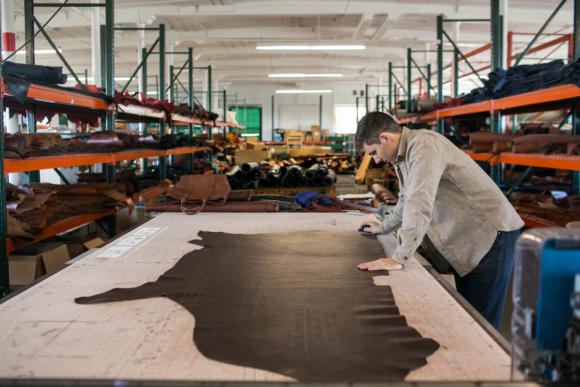
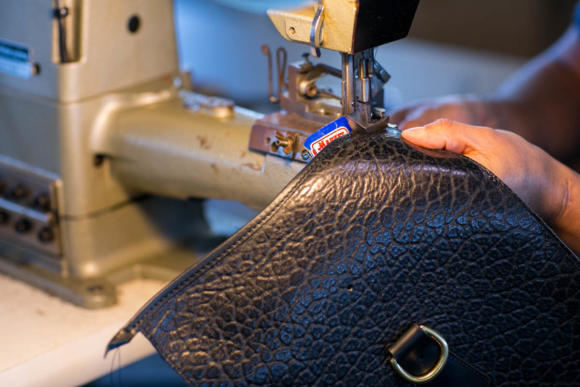
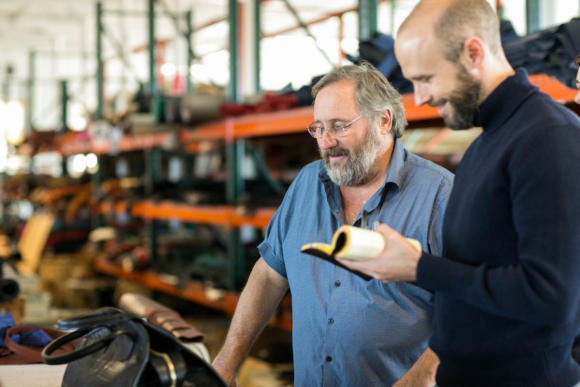
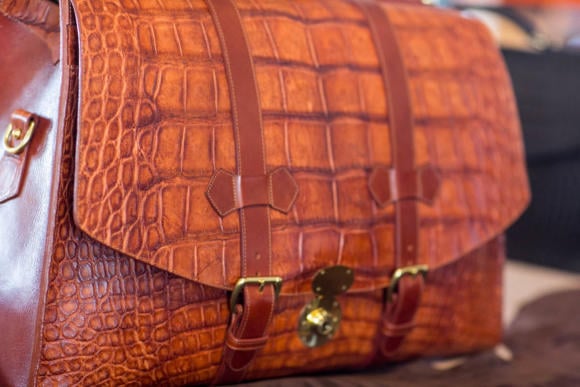
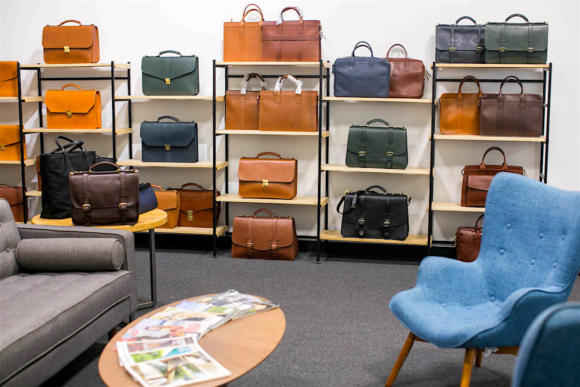
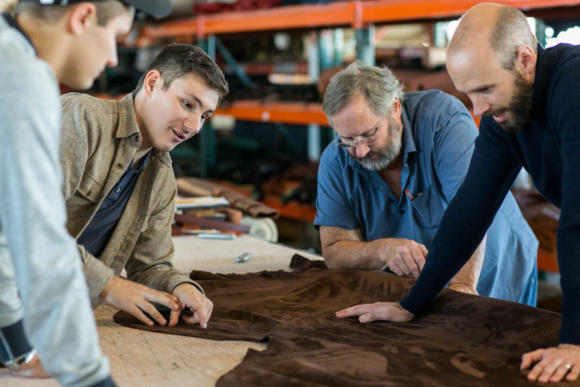
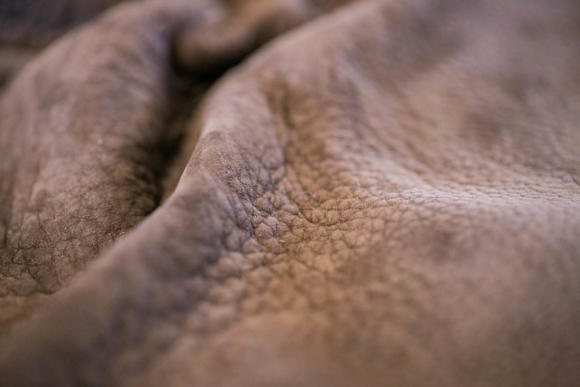
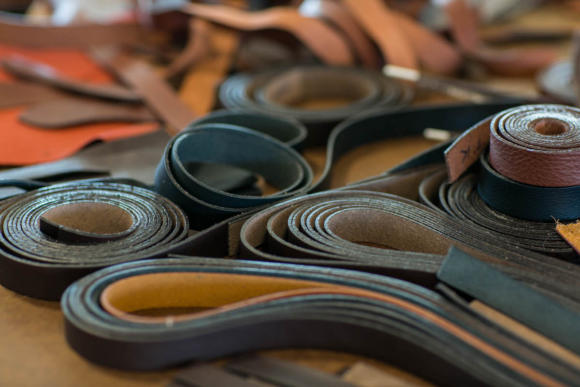
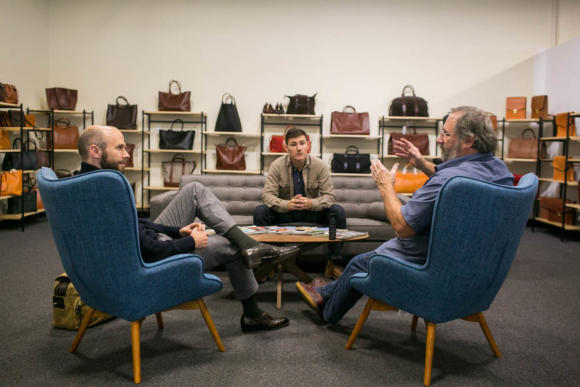
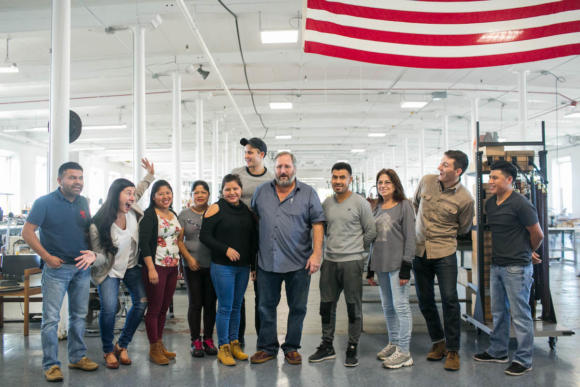
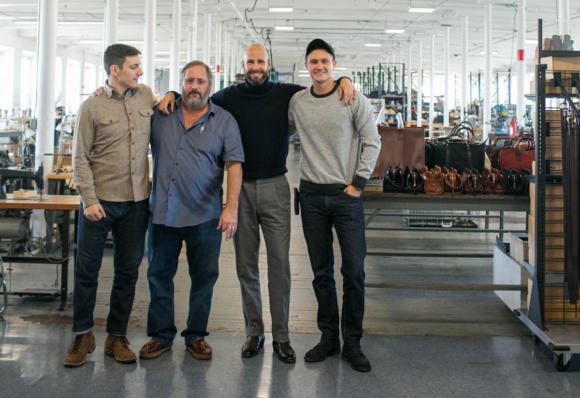
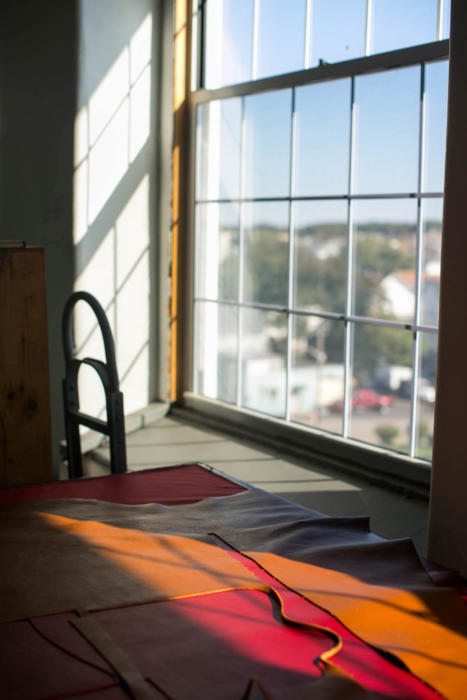


























Any thoughts on Frank Clegg vs for example Ettinger London in regards to quality?Aside from the design of course. I really like the unique designs of Frank Clegg though.
They’re similar – one of the bigger differences might be that Ettinger does a fair bit in bridle leather, like many English makers, which Clegg doesn’t. Bridle ages beautifully but is rather heavy
When exactly was Fall River the richest city in America? With great respect, this assertion is improbable.
Sorry, check the last comment: I doubt New Bedford was ever the Richest city in America. If so it was due to whaling, not milling.
Yes you’re right, whaling may have been the majority. The contrast from the heart of industrial development in the US to now is just as stark though.
The Pequod set off from New Bedford, the whaling ship carrying Ishmael and Captain Ahab in Herman Melville’s Moby Dick. In it (1840) Melville wrote that “. . . nowhere in all America will you find more patrician-like houses, parks and gardens more opulent, than in New Bedford. Whence came they?. . . Yes; all these brave houses and flowery gardens came from the Atlantic, Pacific, and Indian oceans. One and all, they were harpooned and dragged up hither from the bottom of the sea.”
Mid-19th-century. On a per-capita basis. “The City that Lit the World” (with whale fat). Not implausible.
There are several cities that have made that claim I have been too.
From Duluth Minnesota to South Williamsport Pennsylvania.
They have same things in common, I have found:
The claim is “Per Capita” Although no statistics are ever offered, either for comparison to other places, or an absolute basis in the town itself.
The time frame is from 1870 to 1920.
It was all the result of a resource (timber/mining) or transportation (railway/Shipping) boom.
There was a sudden collapse in the 1920’s, and thus emphasizing the contrast to what came before.
Few of them have grown appreciably since, as the reason for their swift ascension evaporated.
I attribute it to a sudden explosion of newly minted wealth (or at least wealthier than most of the general population), especially in a town that may have not existed a couple decades earlier. Since people had limited awareness or the outside world, and there were few reliable statistics – and no income tax to garner information on wealth, a local legend probably took hold…and the anecdotal has become “fact’…
All it takes is for someone to come across a couple prosperous dry good suppliers in the same day, and they start thinking everyone in town is “a millionaire”…
Do you care for any traditional briefcases these days? I’m referring to bags like the Lawyer’s Briefcase that have features like a folding flap, a lock, a straight handle, etc.. I’m not sure many of us can pull them off as a “daily driver” but I wish it wasn’t that way. It’s kind of sad that so many beautiful and practical bags are just not cool now or are too nice to carry with casual clothes.
I do agree, but yes you’re right it doesn’t really work well outside a formal suit job these days
I agree too. A Swaine attache is a thing of absolute beauty, designed to last a lifetime and made by hand, but I do wonder who, apart from the top echelons in the diplomatic and senior service, would buy one these days.
I think that traditional satchels like “English Briefcase,” Custom Hide’s 1945, or Filson’s discontinued Field Satchel will all work just fine with more casual attire.
I’ve had a Filson bridle leather briefcase since the early aughts. I think it was $400 at the time, which is just crazy to think about these days. It’s gotten a ton of use across a range of settings, and I’d say I was wearing a suit probably less than 10% of the time I carried it. The real key is that you absolutely must use the shoulder strap when you’re not wearing tailored clothing. It looks absurd to carry a briefcase in your hand while wearing a Barbour and jeans. I think it’s also very helpful that the bag is VERY dark brown, and it’s starting to show some wear (though after almost 20 years, still just some). A flawless Swaine Adeney Brigg in cognac or lighter will stand out anywhere, but some scratches and creases will make it fit in better.
The main reason that the Filson gets a lot less use these days is less about clothing and more about how work gets done. I just don’t carry much paper anymore, and a multi-gusset briefcase with interior dividers designed to hold files isn’t really what I need. (Incidentally, I’m a litigator, but the briefcase was with me through grad school, a few years of teaching, and law school.) These days I’d rather have a single laptop sleeve with an otherwise undivided compartment. It’s easier to store an AC adapter and a water bottle that way.
I do agree, though, that other briefcase designs are becoming largely outdated. The attache and the top-frame lawyer’s case are almost extinct, and even the strapless fold-over is pretty rare (and harder to dress down than the satchel).
Simon, you’ve mentioned your fondness for Dunhill bags. How would you compare the Frank Clegg quality to Dunhill?
Dunhill does at least two levels of quality – the Duke range, which I have most things in, is superior as it includes lots of hand sewing. The cheaper range is largely on a par with Clegg, perhaps slightly lower quality
The lesser Dunhill range is still more expensive than Clegg. Does that mean Clegg is better value? Clegg doesn’t do handsewn work?
Yes it is better value – with Dunhill you’re paying for a whole lot of brand on top.
Simon,
Thanks for another evocative factory visit.
My wife has an FC ‘Daisy’ bag in red and I have a messenger bag – both of which are a sheer pleasure to use. Beautiful and functional.
It’s therefore a real treat to read about the team and see the photos.
Best wishes.
Look at the bags made by Mackenzie. Would be good to see you supporting more UK craftsmen.
I know them, thanks. And don’t worry, despite being an international site we support plenty of British craftsmen
I like these factory reviews, and have been a somewhat loyal Seraphin customer ever since the review, and will switch from Tumi (sic!) to FC. And thank you so much for not using the words “artisanal”, “boutique”, … I have one FC bag so far, and it seems to be a good bag by a great bunch of people.
Ha! It certainly is artisanal, but the word has rather lost meaning hasn’t it. Handmade is going the same way too
Oh Simon,
This is SO great, lad; I am from that area of the country, and saw it thriving during my youth, only to watch as the industry left, and the hope of the citizens in the area with the jobs. SO happy to see Clegg provide jobs; so happy you got to see, up close, what a great effect said jobs can have on the community. I love this site, and love that you have featured that area. Thank you. Keep up the great work! I may live in Los Angeles now, but part of my heart will always reside in New England. Well done, lad.
How would you compare the quality of the Clegg tote with your Globtrotter collaboration?
Superb looking products. I’ll have to pop into Richard Gelding to see what they have. Personally, I really like the traditional briefcase styles, like the English and Lawyers brief cases made by Clegg. I think that the “flap and strap” aspect of the design is fine with more casual dress, certainly better than attaché cases and some other briefcase designs.
I like these factory visit pieces, partly because most of my working life has been associated with manufacturing, initially in industry and then in academia. Very interesting that Frank went into guitar making for a while and that he currently employs a CNC machine. I’ve engaged with bespoke and custom guitar makers both in the UK and USA for almost two decades and, as a sideline, have written about them in relevant magazines for many years. The reason I mention this is that I was interested to see that none of the commenters made any observations about Frank’s use of CNC in the production of his bags, whereas such technology is often (wrongly, in my opinion) anathema in the handmade guitar community. Interesting how perceptions vary.
I’ve had the zip top briefcase for just over a year now, and I use it daily. It’s by far one of my favourite possessions, and I’ve had numerous people ask me where I got it.
I live in the US (originally from London), and it can be depressing driving through ex-industrial towns, but it’s great to see a company like Frank Clegg can survive by stick to the principles of high quality and solid design. I hope their success continues.
Its wonderful to see in an area that has lost its main manufacturing base that it gives space to smaller operations with more artisanal and handcrafted production, the value of handmade items was important before and as we become more dependant on technology and more mechanised/robotic manufacturing practices I feel it gives handcrafted items with a rich provenance a stronger platform. Thank you for showcasing their work.
Hi Simon,
You have inspired me to purchase a FC zip top briefcase – which color do you think is most versatile? Black or chocolate?
Unless you work in a formal office everyday, probably chocolate
Hi Simon,
Do black does seem a bit more dull in color and texture to chocolate. In this case, would it be comparable to wearing dark brown shoes vs black shoes? Thanks for the advice!
Yes, very similar. And yes, brown is a lot more interesting
Hi Simon. I would appreciate you thoughts and advice on a bag that can be used as a daily commuter bag as well as for a short weekend or business trip (1-2 days). I am considering either the Frank Clegg unlined small duffel in cognac (possibly the larger Signature duffel) or the Bennett Winch commuter bag in olive or navy canvas. Comparing the two, I have the following questions:
1. Which model is likely to be the most versatile (e.g. daily work commute, weekender, business trip)?
2. Which model will last longer and age better (I presume it’s the FC leather)?
3. Is the quality construction of both BW and FC the same or is one superior to the other?
4. Other than Bennett Winch and Frank Clegg, do you have any other recommendations?
Thank you in advance for your help.
Hi Vinay. You’ve made good choices with the two bag brands, and I wouldn’t look beyond them – but they represent rather different styles.
Both will last well and age well, but you’re right the Clegg will do slightly better as leather in that darkness in the leather will probably look more attractive than wearing in the canvas.
My bigger concern with your choice would be that those two styles would be great as an overnight bag, but might be a bit impractical or too casual for a daily business commuter bag. A holdall shape might not be that great for papers, smaller bits for the office etc. But you know what you carry much better than me.
Thanks Simon.
I generally don’t need to take documents and office related items on a daily basis. Most of the time it’s gym clothes, even some food for the day (e.g. fruit) and on the odd occasion I bring documents back and forth from work. I walk to and from work which is about 25 minutes each way so I need a bag that can handle regular use. To be able to carry all these items and also use the bag as an overnight / weekend bag, would you view the BW Commuter or FC as more suitable?
One more question if I may. If you were to compare the recently released BW leather commuter with the FC small/Signature duffel, would you recommend one over the other in terms of overall quality, versatility etc? Both are very similar price points as well but have different types of leather. I wanted to get your view on what you would recommend for my situation.
Thanks for your advice.
To be honest I think all three could work well, and I’d pick based on aesthetics – which you best suits your style, or you like more. There isn’t much difference beyond that, eg in quality
Great. Thanks Simon. What is your
personal preference between a leather BC commuter or the FC leather duffle in terms of aesthetics?
If I were to go for the FC bag, do you think Chestnut or Cognac as colours is reasonably versatile for casual use and business? Or would you opt for something darker? I like how the lighter bags get a more unique patina than say dark brown or black. Thanks for your help.
Personally, Frank Clegg. And I’d always go for something darker to be on the safe side. Chestnut or dark brown
Thanks Simon. You have been most helpful. I just need to decide between the small and the signature duffel from
Frank Clegg. If you have seen both models, would you recommend the small duffel is more suitable for daily use as a commuter, as previously discussed and possibly as a gym bag that can fit into a locker? I haven’t seen the two duffels side by side but I suspect the Signature duffel might be a bit too large. I would appreciate your thoughts. Regards.
The small is probably better as a commuter, yes
Great. Thank you.
Hi Simon,
I came across another option from your website. It is the Carl Friedrik Palissy 25-hour bag. Looks like a nice briefcase but can also fit a small amount of clothing which would work well for gym gear (might need an interior bag for dirty clothes) and for an overnight trip. So it’s the best of both worlds and it comes in what looks like a high quality leather.
Would this be another product you would recommend for my requirements? Looks like a very good price point presumably by cutting out the middle man and going direct to the customer.
How does the quality of this bag (leather, construction, hardware etc.) compare to a Bennett Winch or Frank Clegg leather bag as previously discussed? I’m trying to understand if all three products from three different brands are similar or if one is a standout to the others.
Thank you.
It’s a nice design, yes. A step down in quality of materials though
If I may Vinay. I was looking at both these options for a long time. My criteria was similar: London commuter looking for smart bag to carry lunch, gym wear, wash bag; something that gets better with age and I could stuff in the gym locker. John Lewis have an exclusive wax cotton travel explorer, made by Barbour in olive. It certainly won’t reach the quality and craft criteria of your two options. But it’s worth dropping in to take a look. It’s collapsible, so wears small when carrying light, but will expand large for a weekend bag.
Thanks Richard. I will look into your suggestion.
Dear Simon,
Other than styling, what are the pros and cons of a zip top briefcase vs a flap? (let’s just say both have an external easy access compartment/pocket)
Well, the flap top will generally look a little smarter and more formal. Or is that what you mean by styling?
Was more from a practicality point of view? Is zip top more practical?
Ah, I see. If they both had that exterior pocket, as you say, then it doesn’t make a big difference either way. The zip would be slightly easier to access, but only if you kept it open the time
Hi Simon. Thanks for your earlier advice. I decided to go for two bags for my requirements. For the briefcase I ordered the Frank Clegg zip briefcase, single gusset in chocolate (I agree darker is more versatile). I am looking forward to receiving it in the coming weeks. The second bag is for more casual use including walking/commuting to work with gym clothes etc. It needs to be a bit lighter than say the FC duffles which are quite heavy even when empty. I was considering the Filson small duffle and I had two questions: 1. Would the Filson small duffle still work well in an office environment in terms of versatility (e.g. home to office to gym etc.) or would you recommend another high quality brand/bag that would work better as a daily commuter for a corporate environment as well as a gym bag? 2. What colour, between either the otter green or tan would work better with business wear (suit, trousers, business shirts etc.) and casual clothes? I want the most versatile colour and one that will age well. I know the tan is the classic colour but not sure if that will work in a business environment vs the darker green.
Thanks for your help.
Good to know Vinay.
To be honest I don’t think the Filson is that good with business wear, it’s too casual
Do you have another recommendation ?
Hi,
Simon. Just following up my question from a few weeks back. Why would you recommend as a daily commuter and gym bag is not Filson or B&W Commuter?
Thanks.
Sorry Vinay, I thought I had replied. To be honest I’d go with one of them or Clegg
Thanks. Just to confirm, you would be happy to choose from Filson, Bennet & Winch or Clegg for a commuter/gym bag?
Yes, I think those three bags brands cover a good range
Hi Simon,
Any thoughts on Frank’s new “Commuter Tote” and pros vs cons of this bag vs the Hampton Zip Top Tote? I love the look of the Hampton and that it zips shut, but notice it has few pockets, whereas the Commuter Tote has plenty of pockets but doesn’t zip shut and is maybe a little more of a casual bag? I wear a suit once a week, and dress trousers with sport coat, smart sweater or dress shirt most days, wondering if that tilts your suggestion one way or the other. Thanks!
Personally Kevin I’d go with the Commuter Tote. It’s more practical, and I’ve never felt the need for a zip top. The Hampton is more towards something more for travel
Hello,
I’m thinking of purchasing the Clegg bag as a gift for a friend, my only question is if I should get it lined, or unlined. Which do you suggest?
Thank you,
I think it’s a question of his potential priorities George. The lining is more practical, but seeing the leather is beautiful. If you think he’ll appreciate that aspect of the material, go for unlined. If not, lined.
Hi Simon
Recently , i would like to buy a fank clegg tote, but im struggle on the size of a tote
do you agree that the size of the tote should also depends on the how tall are you?
given that im only 177cm tall, skinny to normal body build, i reli dont know would it be too long for me to pick tall tote, or any alternative ? i hope there is a standard formula to get the result (like suit’s length)
I don’t think there is a standard formula, no, as it depends more on personal taste. I would suggest trying one in person if you can, and see how you feel about it.
There is logic in a shorter man having a smaller bag, but it’s also much more flexible and driven by style.
Hi Simon, i hope you don’t mind me asking for your opinion.
My industry/office environment is of an extremely casual dress style (to wear any shirt is considered dressing up) and I am looking for a daily bag to take to work. I am quite taken by the Frank Clegg commuter briefcase in suede, their sand/chestnut version: https://frankcleggleatherworks.com/suede-commuter-briefcase-sand-chestnut.html. I find the sand suede with the brown strap contrast deeply appealing.
This would be my only bag for this purpose and i am in two minds as to whether the color of this sand/chestnut version strays too far from the safe option of dark brown to be practical. I feel the colours are muted enough for everyday use (and as i say, i have no need for formal dressing), but i can’t help but feel that dark brown would be safer and less likely to result in buyers remorse. I am hesitant with this purchase as last year i bought a 50% discounted messenger bag from Tods for daily use, but the extreme tan/orange colour has become too much to bear; an impulse buy, driven by the heavy discount.
I’d very much value your opinion on what you think of the versatility of this sand/chestnut version. Many thanks!
To be honest John, I was all set to say you should go with dark brown. It is the right decision in 90% of cases.
But actually, I think the sand/chestnut here is nice, casual and versatile. I wouldn’t worry about going with it. A darker brown would still be less noticeable and perhaps more practical at a pinch. But this isn’t an unusual or risky choice.
The only thing I’d be slightly unsure about is the suede. I feel like this colour combination is meant to be in canvas for the body (cf Filson) and I’d worry it might look odd. But it’s hard to say on that without seeing it in person.
Thanks Simon, appreciate and value the feedback.
Hi
Which turtle neck are you wearing in this article?
I am looking for a good turtle neck that I can wear along with a sports jacket
Hey Sajeer,
That’s an old Drake’s one. I’d suggest looking at Colhay’s for a good range